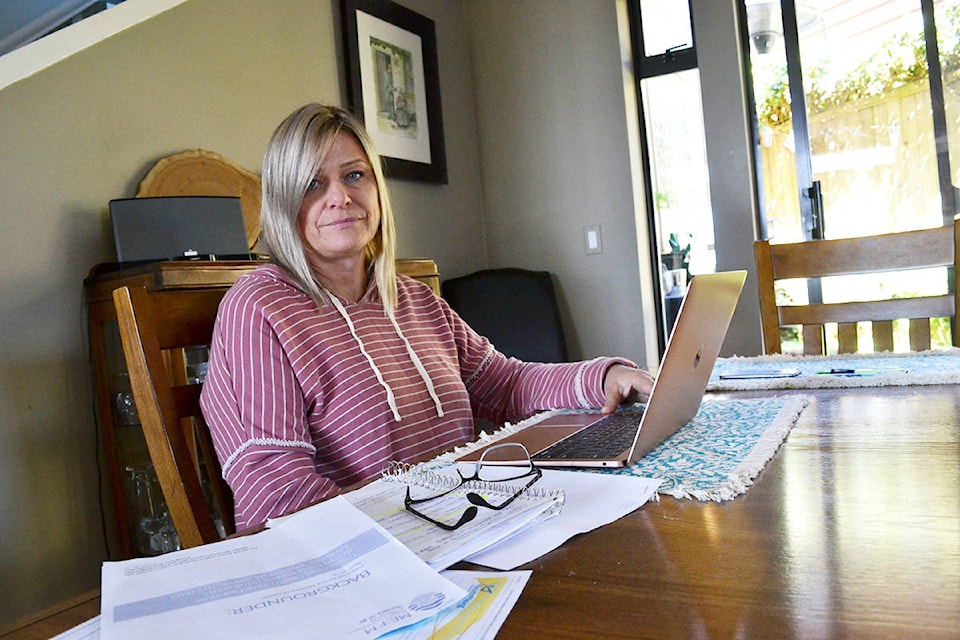As a former college educator who taught dental hygiene, Alma Pauw, 55, used to pride herself on her ability to multitask.
Several years ago, however, the White Rock resident started to notice a change in not only her cognitive ability, but her level of physical energy.
Sitting at her kitchen table Tuesday, Pauw described changes she felt in her body starting in 2012. She described coming home from work, barely able to keep awake during the drive, and her body shutting off once she got home.
She would lay down at 4 p.m. and would be out cold until 6 a.m. the following day. Even then, she would wake up tired.
This routine carried on for years.
A former runner, she also noticed that the distances she was able to run began to dwindle to a point where she could hardly complete one loop around a track.
“It felt like I had tree trunks for legs and I had to carry those home,” she told Peace Arch News. “That was kind of a trigger.”
Her doctor, who she had seen for more than 10 years, wasn’t able to identify what was wrong. She underwent a series of tests, but they turned up nothing.
READ MORE: Surrey teen spends World Lupus Day telling students about disease that changed her life
In the meantime, she was missing out on family life, her social life and work.
“I honestly thought I was dying because I couldn’t pinpoint what was wrong with me,” she said. “At this point, I thought, if it’s cancer, I don’t care.”
However, after a change of doctors and nine more months of tests, Pauw finally learned, in 2015, what was wrong. The same year, she went on long-term disability from work.
Pauw was diagnosed with a relatively rare neuro-immune disease known as myalgic encephalomyelitis (ME), which is sometimes referred to as chronic fatigue syndrome.
The symptoms, which vary from patient to patient, can include intense fatigue, post-exertion malaise, sleep dysfunction, pain and neurological/cognitive manifestations.
Pauw described the pain as similar to that of having a flu coupled with mono.
Another challenge, Pauw said, is the sheer level of unpredictability that’s associated with the symptoms, particularly the fatigue.
READ MORE: B.C. Hockey coach to get kidney after peewee team’s video search
She said on one day, she may be able to complete several light tasks. On other days, she doesn’t have the strength to hold up her phone or brush her teeth.
Her ability to multitask, she said, is no longer there. If she tries to exert herself, whether physically or mentally, her body “shuts down.”
“Sometimes the fatigue is so bad… I can’t even lift my arms. Those are the severe days, which are fairly common and unpredictable.”
A report from the Myalgic Encephalomyelitis & Fibromyalgia Society of BC says that Canadian ME research is “essentially non-existent.”
“Research capacity is severely limited as very few scientists enter the field, choosing instead well-funded research areas,” the report states.
Frustrated with the lack of research funding the condition receives, Pauw said she contacted PAN to raise awareness about the disease, which affects approximately 70,000 people in British Columbia.
A challenge with raising awareness about the disease, Pauw said, is that the people affected by the condition have little energy to lobby government.
“Our population is probably the least energetic physically and mentally.
“It’s creating quite a challenge to do this. But I think if other people are aware of this… that would be my goal, to make one person aware of it. Hopefully, that person would be the government.”
Pauw expressed frustrations with how symptoms of the disease may be perceived by other people. For years, she used to hide it from people in her circle – and she still does, to some extent, she said.
The disconnect, she explained, is when she explains to somebody that she’s fatigued. People tend to use their personal experience of fatigue as a reference point to understand Pauw’s condition.
However, she described the level of fatigue she experiences as “horrendous.”
“Pacing is the hugest thing that keeps this disease a little under control,” she said, adding that if she does make plans, she will spend the entire previous day resting.
But even then, the unpredictability of her symptoms makes it hard to keep appointments, she said.
“The nature of our disease is last-minute.”
Next month, MissingMillions Canada is hosting a “days of action” from May 5-12 to raise awareness about the condition.
“We will take to the streets – or demonstrate from our beds – to show the world we are here,” says a statement on the organization’s website.
People affected with the condition are planning a protest at the B.C. legislature on May 15 from 11:30 a.m. to 2 p.m. Other protests are scheduled throughout Canada and the U.S.
For more information about the event, and information on the condition, visit www.millionsmissingcanada.ca
Pauw recommended that people watch the documentary Unrest, which tells the story of Jennifer Brea, a Harvard PhD student who was diagnosed with ME.
aaronhinks@peacearchnews.com
Like us on Facebook and follow us on Twitter
